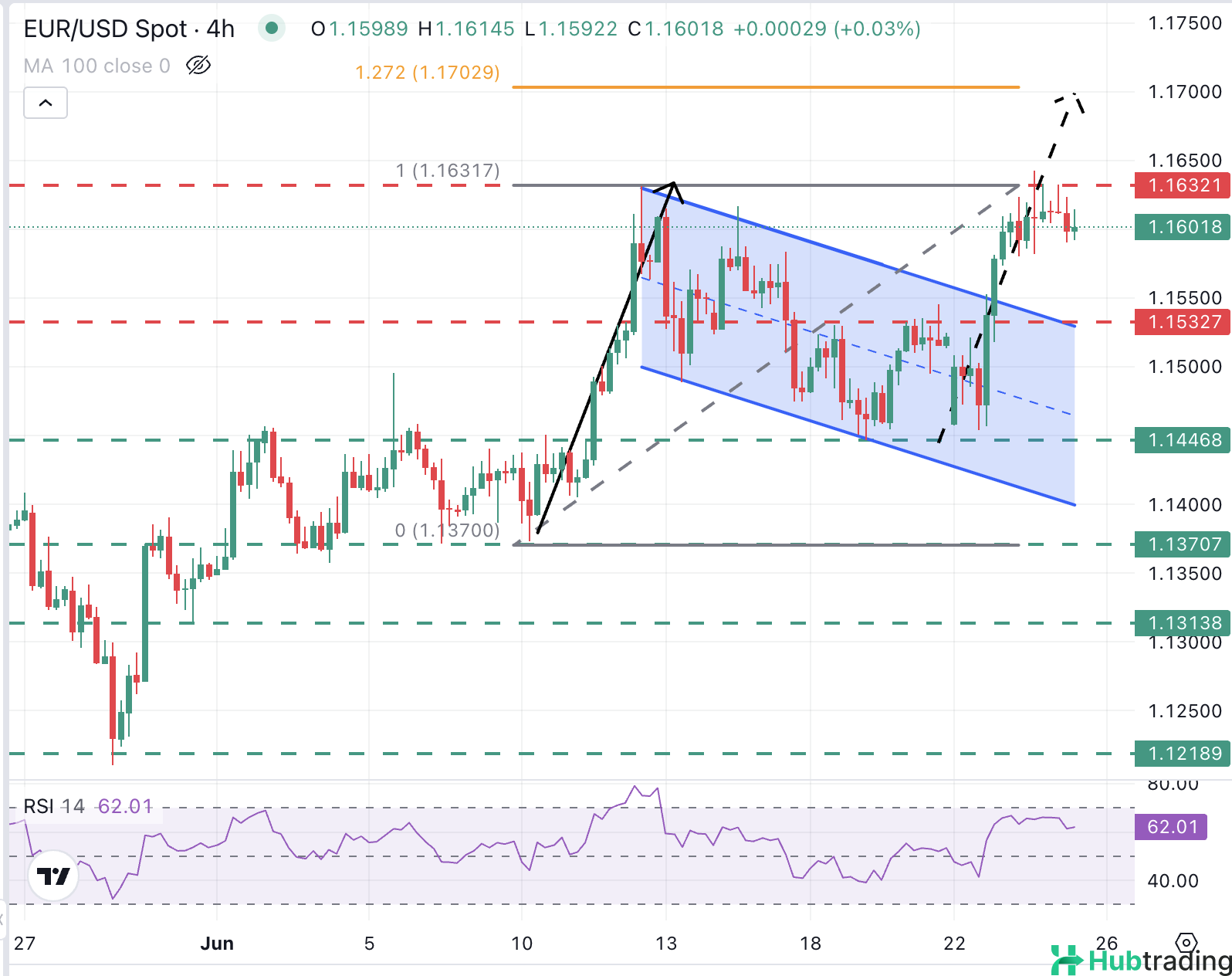-
The Euro holds near three-year highs against the US Dollar, supported by a steady risk-on sentiment.
-
Falling oil prices have boosted the Eurozone’s economic outlook.
-
Soft U.S. data and growing expectations of Fed rate cuts continue to pressure the US Dollar.
EUR/USD is trading with slight losses on Wednesday but remains close to a multi-year high near 1.1640, a level not seen since November 2021, following a strong 1.40% rally over the past two days. A moderate risk-on mood continues to support the Euro, despite ongoing uncertainty surrounding the Israel-Iran ceasefire, keeping the safe-haven US Dollar under pressure.
While oil prices have bounced slightly from Tuesday’s lows, they remain well below last week’s highs. Iran’s oil and gas infrastructure appears largely unaffected by recent bombings, and for now, there are no signs of disruption to crude shipments through the critical Strait of Hormuz. Lower oil prices are offering additional support to the Euro by easing inflationary pressures across the Eurozone.
In the U.S., Federal Reserve Chair Jerome Powell reiterated during Tuesday’s testimony to Congress that the central bank is in no hurry to cut interest rates. Despite political pressure from President Trump and diverging opinions among Fed officials, Powell maintained a hawkish tone, reinforcing the Fed’s cautious stance.
However, markets continue to price in a potential rate cut in September, particularly after the release of disappointing U.S. consumer confidence data on Tuesday. Growing concerns about employment are dampening consumer sentiment and fueling speculation that the Fed may need to shift toward a more accommodative policy stance.
Powell is scheduled to speak again on Wednesday, but any significant deviation from his prior remarks appears unlikely. With a light U.S. economic calendar—featuring only May’s New Home Sales data—market focus will remain on geopolitical developments in the Middle East for further direction.
Daily Digest Market Movers: Risk Appetite and Fed Cut Bets Keep the US Dollar Under Pressure
- The Euro (EUR) continues to gain ground, supported by ongoing weakness in the US Dollar (USD). The US Dollar Index (DXY), which measures the Greenback’s strength against six major currencies, remains under pressure near a three-year low of 97.60. This decline is driven by improving global risk sentiment following the fragile Israel-Iran ceasefire and growing market expectations for a Federal Reserve rate cut, potentially as early as September.
- While the ceasefire, announced by US President Donald Trump on Monday, remains intact for now, US intelligence reports cast doubt on its longevity. Preliminary assessments suggest that US strikes on Iran’s nuclear facilities have delayed the program by only one to two months—far less than the "obliteration" previously claimed by Trump. As a result, while markets are cautiously optimistic, the geopolitical outlook remains uncertain.
- Eurozone economic data released this week has provided mild tailwinds for the Euro. On Wednesday, French Consumer Confidence held steady at 88, slightly below expectations for a rise to 89. In Spain, final Q1 GDP data confirmed 0.6% quarterly growth and a 2.8% annual increase, in line with earlier estimates.
- Meanwhile, Tuesday's German IFO Business Climate Index rose to 88.4 in June from 87.5 in May, narrowly beating forecasts of 88.3. The Business Expectations subindex also improved to 90.7 from 88.9, surpassing the 90.0 forecast. However, these figures had only a limited impact on the Euro, as market focus remained centered on broader macroeconomic drivers and US monetary policy expectations.
- In the US, consumer sentiment disappointed once again. The Conference Board’s Consumer Confidence Index fell sharply to 93.0 in June from a revised 98.4 in May, missing the anticipated increase to 100.0. The report cited growing concerns over job availability and the broader economic outlook, reinforcing worries about slowing economic momentum.
- Despite this, Fed Chair Jerome Powell maintained a cautious stance in his semiannual testimony to Congress, stating the central bank is “well positioned to wait” before adjusting interest rates. Powell highlighted the inflationary impact of proposed tariffs, suggesting they could dampen economic activity.
- Still, market participants are increasingly betting on rate cuts. According to CME Group’s FedWatch tool, the probability of a rate cut in July has risen to 18%, while the likelihood of a September cut has jumped to 85%, up from 14% and 65% respectively just one week ago.
EUR/USD Technical Outlook: Bulls Eye 1.1700

EUR/USD remains on a bullish path after breaking out of a multi-week consolidation channel, buoyed by risk-on sentiment following news of the Middle East ceasefire. The pair is currently testing resistance at the June 12 high of 1.1630.
A breakout above this level would confirm a bullish flag pattern, pointing toward a potential target around the 1.1700 area. This projection aligns with the 127.2% Fibonacci extension of the June 10–12 rally.
On the downside, initial support lies near 1.1535, the former trendline resistance that now serves as a potential pullback level. A break below this area would invalidate the bullish setup and bring attention back to the lows seen on Thursday and Monday, around 1.1445.





